Evaluating Alfalfa Stands for Winter Injury & Winterkill
Will you have enough alfalfa forage this coming year
Evaluating Your Alfalfa Stand for Winter Injury/Winterkill and Your Options
By Don Miller, Director of Product Development, Alforex Seeds
Back to back years of harsh weather conditions have taken a toll on alfalfa stands across the U.S. The winter of 2018-2019 was quite severe, with some states seeing record winterkill and winter injury of alfalfa stands. This was followed by very wet summer and fall conditions that hampered the establishment of new alfalfa plantings and further weaken existing stands. With these extreme weather conditions, many alfalfa producers are asking the following questions:
-
- Did my old alfalfa stands make it through this winter?
- What affect did the wet summer and fall have on my new plantings of alfalfa?
- Will I have enough alfalfa forage this coming year?
- What are my options?
Before We Address These Questions, Let’s First Consider The Risk Factors That May Have Contributed To Winter Injury:
2019’s Extreme Wet Soil Conditions: Possible Detrimental Effects
- High Soil Moisture: Winterkill occurs more often in wet soils
- Plant Heaving: The freezing and thawing of wet soils during the winter can result in the alfalfa crowns being pushed several inches out of the ground. These exposed roots are subject to mowing damage in the spring which often results in plant death.
- Flooding: Fields submerged for more than 10 days generally don’t survive.
- Root Disease: Wet soil conditions for extended periods also foster root diseases such as Phytophthora and Aphanomyces root rot. These diseases can significantly reduce alfalfa yields due to plant stunting and/or death. Fungicide Seed treatments such as Apron and or Stamina can enhance seedling survival in cool wet soils.
Weather Conditions Contributing to Winterkill and/or Plant Injury
- Poor Snow Cover: Open winters without snow cover can result in very low soil temperatures causing root crown damage and possible plant death. Stand losses can occur if soil temperatures, at a depth of 4 in, reach 15 to 17 degrees (F).
- Ice Sheeting: Warm periods that melt snow cover followed by freezing temperatures may result in ice sheeting in low lying areas of the field. Plants under ice for more than 30 days rarely survive.
- Warm Mid-Winter Periods Followed by Sudden Cold Temperatures: If an alfalfa plant breaks dormancy during an extended warm period during the winter, it loses its tolerance to subsequent cold weather and may winterkill.
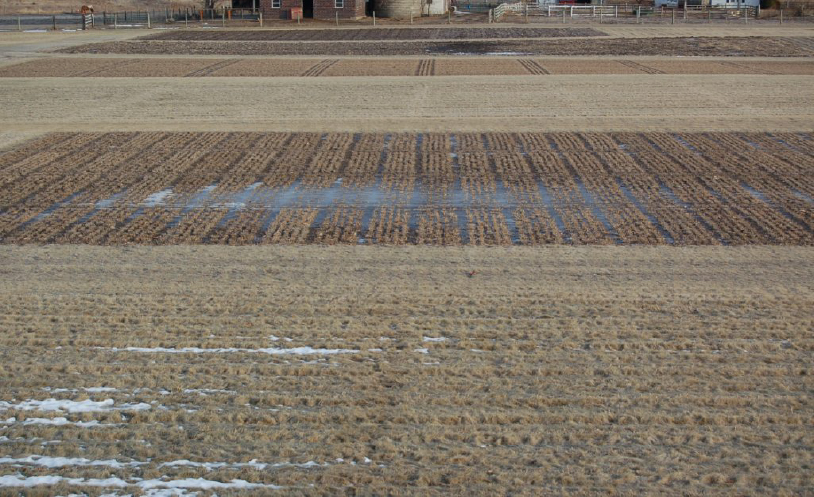
Ice Sheeting
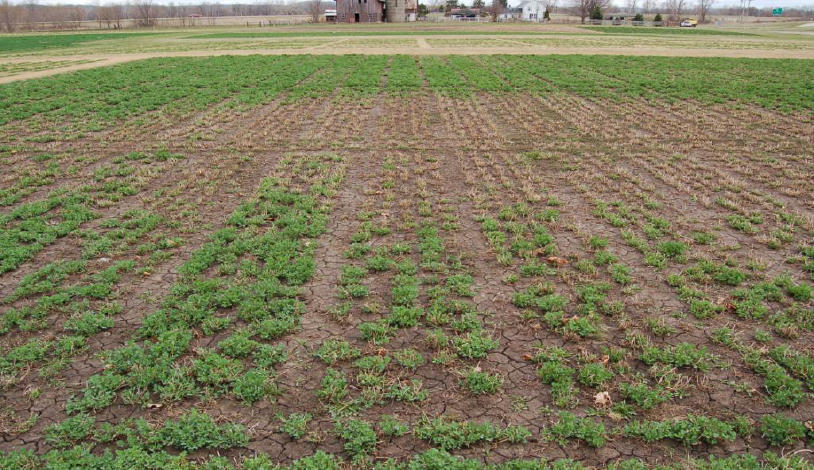
Damage caused to an alfalfa field by winter ice sheeting.
Crop Management Can Influence Plant Survival
- Variety Choice (Fall Dormancy and Winter Survival Index): First, having the variety with the appropriate Fall Dormancy (FD) and the Winter Survival (WS) for your location is critical in minimizing the chance of winterkill. Over the years there has been a trend to plant a higher dormancy ( FD=5 vs. FD=4) to gain yield, however to avoid winter injury, these varieties must also have a WS value in the 2’s or lower to give some assurance of adequate winter survival.
- Age of Field and/or Plant Health: The initial varietal selection of an alfalfa with a good disease and pest package can enhance winter survival. Older fields are more prone to winterkill, in part due to their higher incidence of root disease. Diseased plants have a lower survival rate in severe winters.
- Soil Fertility: Adequate soil fertility is needed for plant health. Potassium is especially important for winter survival.
- Aggressive Cutting Schedules: Frequent short harvest intervals during the growing season without a period of full recovery, especially on the last cut before winter, can be detrimental to the alfalfa fields winter survival.. Full recovery is reached at flowering stage where there is enough top growth photosynthesis to replenish root food reserves.
- Timing of the Last Cut: The last cut date can greatly influence how well an alfalfa field can survive the winter. The last cut must be made to insure that the plants have optimal root reserves going into the winter. The last cut date varies by location, but Midwest growers generally avoid cutting after September 1st.
- Cutting Height: The practice of leaving 4-6 inches of alfalfa stubble after the last cut can be very beneficial in collecting adequate snow cover to provide some insulation to the alfalfa plant from cold winter temperatures.
Evaluating Alfalfa Stands For Winterkill:
Types of Winterkill Damage
- Cold Injury of Crown and Roots: Plants that have gone dormant can tolerate temperatures as low as 5 °F without damage. However plants can lose their ability to survive cold temperatures if there is a mid – winter warm period where the plant break dormancy. A sudden change back to cold temperatures can result in winter injury. Plants generally winterkill if soil temperatures (at 2-4 Inches) reach in the range of 12-13 degrees F or lower.
- Ice Sheeting: This condition occurs when melting snow or rain refreezes during the winter, completely covering plants. This type of winterkill can be quite severe, especially if the ice covers the alfalfa for more than 30 days. Plant death is attributed to the lack of oxygen under the ice. Plant death may occur more often in low lying areas of fields where water can pool and freeze.
- Heaving: Repeated freezing and thawing conditions in an alfalfa field can result in the pushing of a portion of alfalfa root out of the ground. In severe cases the top 2-4 inches of the crown and root may be exposed above the soil surface. These exposed crowns are often cut off during the first harvest resulting in plant death.
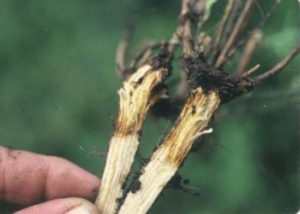
Frost damage to the alfalfa plant’s crown.
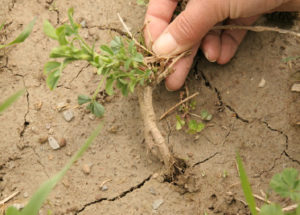
Alfalfa plant winter heaving.
How and When do I Check for Winterkill?
- Evaluate Field Damage After You See 3-4 Inches of Top Growth: It is best to wait until the alfalfa starts to break dormancy and has 3-4 inches of top growth before you evaluate the stand. Determination of which plants actually have died or have significant damage is much easier once the plants start to grow. Once you see top growth, walk the field and look for damage. Damaged fields will display an abnormally slow green-up in the spring with uneven plant growth.
- Dig Plants: For the most accurate estimate of the health of the field you should dig up 20-30 plants in several parts of the field and check the crown and roots for damage. If the top inch or two of the crown and root are soft and brown, that is a good indication that that plant is dead or severely damaged. It should be noted that the lower part of the tap root may still look healthy and firm, but if the crown or top of the root are soft, the plant will not recover.
- Check Extent of Crown Damage: Plant damage may range from none to complete plant death. Healthy plants will have crown bud growth on all sides of the crown area. Damaged plants may have asymmetrical bud grow on one side of the crown with dead buds and tissue on the other side. Healthy undamaged crowns and roots should be firm and white on the inside if cut open. Brown discoloration in the crown and taproot are symptoms of winter injury and/or root disease. Severely damaged plants with 50% of the crown showing winter injury will most likely die early in the season. If a large percentage of the plants evaluated are dead or showing significant winter injury, rotating into another crop may be the best option.
- Optimal Stand Count: Depending on the age of the stand, the optimal stand density can vary. In new stands the optimal beginning stand count is 25-35 plants per sq. ft. In older stands (3-4 yrs.) the minimum number of plants is 6 plants per sq. ft. In evaluating stands with significant winter injury a better estimate of the stand is the number of stems per sq. ft. A productive field will have an optimal stem number of 55 stems per square foot or greater. Fields with stem counts below 40 stems per square foot are less productive and rotation into another crop may be the best option.
Options For Salvaging A Field With Moderate Winter Injury
If you want to salvage a weak field for one more season, you have several management options that will minimize further plant death by reducing plant stress:
- Delay First Spring Cut: This will allow the injured plants more time to recover and replenish root food reserves before the first cut, minimizing harvest stress.
- Relaxing the Harvest Interval Between Cuts: A longer growth period that allows the early cut to flower, will significantly reduce harvest stress.
- Optimize Soil Fertility Before First Cut.
- Control Weeds: Weed pressure needs to be minimal.
- Raise The Cutter Bar an Inch or Two Higher on the First Cut.
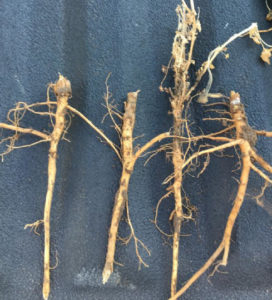
The top of all of these alfalfa roots were frozen 1-2 inches deep into the soil . This was deep enough to kill the crown area of these young plants. This growing point is where the crown buds are generated, that produce the plant’s stems and leaves.
Without this crown area , the remaining healthy looking lower taproots will eventually die.
What Are My Options If I Have Significant Winterkill?
- Rotate Out of Alfalfa: If the winterkill is severe your best option is probably to rotate out of alfalfa and take advantage of nitrogen credit. That field will need to be out of alfalfa for one year to avoid autotoxicity in new alfalfa plantings.
- Interseed with Alfalfa: Autotoxicity is not a concern if you want to replant a spring or fall planted alfalfa the following spring. Fields less than a year old, can be replanted without autotoxicity concerns. Thickening older fields (2-4 yrs.) with new alfalfa seed is generally not a good option due to autotoxicity concerns.
- Interseeding With Grass: Adding a high productive grass into the alfalfa field for one season can significantly boast the fields yield and provide an emergency forage to compensate for lost forage production.
Need More Forage: Consider Direct Seeding A New Alfalfa Field.
If your operation needs to plant more alfalfa acres to compensate for lost production, make sure you choose the best alfalfa variety to fit your needs. Select a variety that has a good disease package and the traits to match your production needs. To minimize chances of future winterkill, choose a variety with a Winter Survival (WS) rating of 2.4 or lower).
Don’t limit your profit potential the next 4 years with an inferior alfalfa variety that doesn’t fit your production needs even if it may save you a few dollars during the initial seeding year. The cost of alfalfa seed with new technology is often recouped during the first production year with increased yield and/or forage quality.
References:
Below are two University publications that can be found on the internet that can help you evaluate your established stands?
(a)Alfalfa Stand Assessment: Is this Stand Good Enough to Keep? UW Extension Bulletin A3620
(b) Evaluating and Managing Alfalfa Stands for Winter Injury. by Dennis Cosgrove and Dan Undersander, Focus on Forage – Vol. 5: No. 8


Comments
Evaluating Alfalfa Stands for Winter Injury & Winterkill — No Comments
HTML tags allowed in your comment: <a href="" title=""> <abbr title=""> <acronym title=""> <b> <blockquote cite=""> <cite> <code> <del datetime=""> <em> <i> <q cite=""> <s> <strike> <strong>